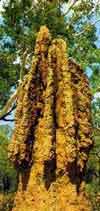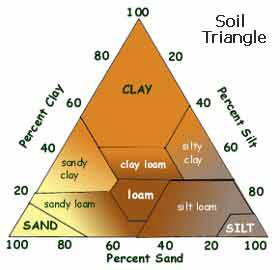THE NATURAL ENVIRONMENT
Geography 101
ToC
WATER
Cycle
Balance
Water In
Water Out
Soil
Classify
Soil
 "soil - (i) The unconsolidated
mineral or organic material on
the immediate surface of the earth that serves as a natural
medium for the growth of land plants. (ii) The
unconsolidated mineral or organic matter on the surface of
the earth that has been subjected to and shows effects of
genetic and environmental factors of: climate (including
water and temperature effects), and macro- and
microorganisms, conditioned by relief, acting on parent
material over a period of time. A product-soil differs from
the material from which it is derived in many physical,
chemical, biological, and morphological properties and
characteristics." (USA Soil Conservation Service)
"soil - (i) The unconsolidated
mineral or organic material on
the immediate surface of the earth that serves as a natural
medium for the growth of land plants. (ii) The
unconsolidated mineral or organic matter on the surface of
the earth that has been subjected to and shows effects of
genetic and environmental factors of: climate (including
water and temperature effects), and macro- and
microorganisms, conditioned by relief, acting on parent
material over a period of time. A product-soil differs from
the material from which it is derived in many physical,
chemical, biological, and morphological properties and
characteristics." (USA Soil Conservation Service)
|
|
BOX 1 |
There is a lot more to soil than you might imagine. To a soil scientist, it is not merely small fragments of rock. Instead it is a highly complex, life sustaining mixture of mineral, air, water, and organic matter that evolves over very long time periods; essentially an amalgam of elements from the four spheres discussed in Chapter 1 -> Spheres.
In the previous section, we discussed soil's important role in the surface water balance through infiltration. In this section, we move on to examine the soil itself, its profile, properties, and classification.
What Soil Is Made Of
Soils are made primarily of decomposed rocks, also called mineral matter or mineral grains. Many processes at the surface cause rock to weather and break down and the resulting tiny residual pieces become the basic matrix for soil. The mineral grains in soil are largely insoluble in water, but the small amount that does dissolve provides an important solution of elements essential to plant nutrition. The most common elements in soil minerals are silicon, aluminum, oxygen, and iron, but many others are also present. The particular rock that mineral grains originate from, called the parent rock, can determine many properties of the soil itself, although this influence will decline with age.
 Air is
also an essential component of soils; as much as 50% (but usually less)
of a soil's volume may simply be voids between mineral
grains.
The presence of air is absolutely essential for the tiny organisms that live beneath the surface and become an important
part of the soil itself.
Air is
also an essential component of soils; as much as 50% (but usually less)
of a soil's volume may simply be voids between mineral
grains.
The presence of air is absolutely essential for the tiny organisms that live beneath the surface and become an important
part of the soil itself.
Soil water not only supplies plant roots
with transpiration water, but provides the primary means of moving elements
through the soil. Some water is held very tightly to the surfaces of soil
grains by capillary action, but water that evades plant roots will slowly filter downward
under the pull of gravity. As
water filters downward, it carries tiny loose
mineral grains and dissolved elements with it, which are eventually deposited
deeper beneath the surface. This process of removal of tiny soil grains
and dissolved elements is called eluviation and the process
of deposition at lower depths is called illuviation. This
continual movement of soil elements downward creates distinct layers in
the soil,
shaping
the soil profile, which is discussed below.
Soil also contains organic matter, dead and decaying bits of plants and animals called humus. Humus helps the soil in many ways. It provides nutrients for plants, makes the soil more porous and better aerated, acts as a catalyst for chemical reactions, and increases the water holding capacity. The many small organisms living in the soil also serve important roles. They help break down humus, open up holes in the soil increasing aeration, and help mix nutrients throughout the soil profile. Termite mounds are a famous example of soil organisms improving soil fertility. They mix enormous amounts of soil and help bring deep nutrients to the surface. They break down tough plant material (cellulose), speeding decomposition. And of course, they bore holes into the hard, encrusted soils of the semi-arid tropics increasing aeration.
 The
interaction of these components produces distinctive
soil profiles. While details of the profiles vary greatly
from place to place depending on parent material and the
prevailing climate,
fundamentally
they all share several basic layers that soil scientists call horizons.
The surface layer, known as the O
horizon,
consists of dead and decomposing organic material (humus). Beneath
this layer, a mixture of mineral grains and humus form a dark A
horizon, sometimes called topsoil.
Water passing through this layer carries nutrients and tiny particles to
lower depths, making this a layer of eluviation. These
particles are deposited in the B horizon,
making it a layer of illuviation. This layer is typically
lighter in color than the A horizon due to the absence of humus. Beneath, lies a layer of weathered
and
broken parent rock called the C horizon.
The
interaction of these components produces distinctive
soil profiles. While details of the profiles vary greatly
from place to place depending on parent material and the
prevailing climate,
fundamentally
they all share several basic layers that soil scientists call horizons.
The surface layer, known as the O
horizon,
consists of dead and decomposing organic material (humus). Beneath
this layer, a mixture of mineral grains and humus form a dark A
horizon, sometimes called topsoil.
Water passing through this layer carries nutrients and tiny particles to
lower depths, making this a layer of eluviation. These
particles are deposited in the B horizon,
making it a layer of illuviation. This layer is typically
lighter in color than the A horizon due to the absence of humus. Beneath, lies a layer of weathered
and
broken parent rock called the C horizon.
The O horizon is organic and the C horizon is mineral. Between them lies the true soil, whose layers are distinguished by whether elements and tiny particles are eroded away (the A horizon) or deposited (the B horizon).
Can you see why termites help soil fertility by tunneling deep into the ground through the soil layers? They burrow into the B horizon where nutrients have been deposited and carry those essential elements back to the surface.
This process of eluviation and illuviation is particularly pronounced and deep in the tropics. Aluminum, for example, is one of the most resistant elements to chemical decomposition from its parent rock. After millions of years of exposure to heavy rain and high temperatures, however, it will eventually accumulate into concentrated deposits in the B horizon forming what miners call bauxite, an aluminum ore.
Soil Characteristics
 A
soil's texture is one of its most recognizable
characteristics. It simply refers to the range of sizes that make up the
soil matrix. Everyone
is familiar with the terms clay, silt,
and sand. In soil science,
these terms have exact meanings. They refer to the size of the mineral soil fragments
as shown in the Table.
A
soil's texture is one of its most recognizable
characteristics. It simply refers to the range of sizes that make up the
soil matrix. Everyone
is familiar with the terms clay, silt,
and sand. In soil science,
these terms have exact meanings. They refer to the size of the mineral soil fragments
as shown in the Table.
texture |
size (mm) |
|
clay |
< 0.002 |
|
silt |
0.002 to 0.05 |
|
sand |
0.05 to 2 |
|
Clay is smallest, then silt, then sand. Soil can be dominated by one grain size or it can be a mixture. The various possible mixtures are shown in the Soil Triangle diagram along with their names. Loam refers to a soil that has approximately equal percentages of clay, silt, and sand.
Texture is quite important for plant growth. Loamy textures are preferred as the large sand particles help aerate the soil and allow for drainage, while smaller particles help retain water and nutrients.
Soil color is one of the most obvious characteristics, and perhaps one of the least important. Color may provide clues to the processes that affect soil however. Red colors are usually a product of iron oxidation. White often indicates that iron has been removed. Black soils usually have a high organic content.
Other important characteristics relate to soil chemistry. Soil fertility, the ability to support plants, depends on the presence of tiny particles of clay and organic material called colloids. Colloids electrically attract and hold fertility cations, or nutrients, in the soil, such as Calcium (Ca), Potassium (K), and Magnesium (Mg). When erosion carries away the topsoil, soil colloids are carried away as well leaving the soil infertile and making it difficult for plants to grow. Another cause of infertility relates to soil acidity. Acid in the soil strips nutrients from colloids and allows them to be removed in solution as water filters downward.
Finally, soil water is an extremely important soil characteristic. The amount of water held in soil that is available to plant roots (remember the root zone in the Balance section?) is called the field capacity of the soil. This varies greatly with soil type and root depth. If water is not added to the soil, roots will continue extracting water from soil moisture until the field capacity has been depleted. When this happens the plant is said to have reached its wilting point and the above ground portion will wither.